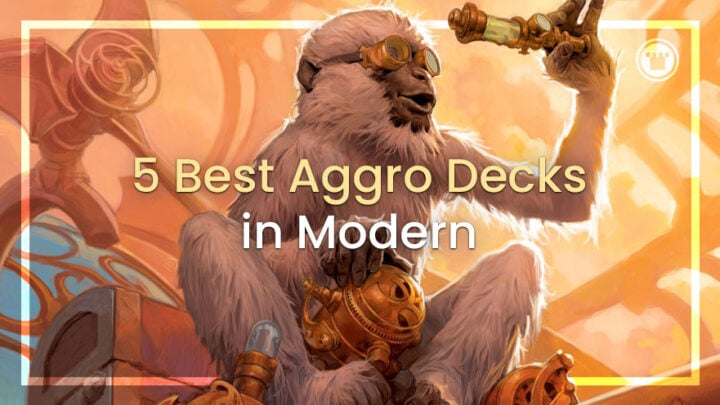Aggression has always been a common play style in Modern, but it has outgrown hyper-linear decks that “try to kill your opponent as fast as possible without interacting” — decks like Burn. That’s why you won’t see the famous archetype on this list of the best Aggro decks in Modern despite the fact that it’s still around and seeing play.
What is the reason for this change? The paradigm has shifted, and Aggro decks in Modern are better served finding ways to interact with Midrange and Combo decks, the latter of which are often able to outpace raw aggression if left alone.
A lean, low to the ground Aggro deck with cheap interaction can pressure the opponent from both a life total perspective and a time perspective. And the way I see it, Aggro decks are just looking to utilize the declare attackers step early and often.
Aggressive decks in Modern aren’t going to look like aggressive decks in Standard or Pioneer. If we view aggression as a spectrum instead of a binary, we see how this archetype is relative to the rest of the format.
Newer formats have aggro decks with somewhere in the realm of 30 creatures, and they’re going all in to be as fast as possible. Modern decks on the other hand are going to have somewhere in the realm of 20 creatures which is a significant drop, but we have to fit interaction somewhere. Let’s take a look at some decks to see what I mean.
Murktide
Murktide is the most interactive of the decks I’m going to look at today. Able to take a more controlling role by sitting back on counterspells, Murktide is also fluid and adaptable enough to be the aggressor with Ragavan, Dragon’s Rage Channeler and a flurry of Lightning Bolts that put the screws to opponents starting on turn one.
Unlike an Humans, an Aggro deck that has fallen out of favor, Murktide is strong against combo decks given its density of counters. If decks like Humans were around today, they would struggle greatly against decks like Living End and Creativity, both of which Murktide handles with ease.
Murktide doesn’t need to rely on pure aggression to win games, because by blending aggression and interactivity, it can still be fast enough to keep slower decks on their heels without becoming vulnerable to decks like Creativity, Living End and Amulet Titan.
Hammer
Hammer is debatably a combo deck, but given its proclivity to attack early and often, it is close enough for me to consider it an aggressive strategy. This archetype is likely the most extreme end of the aggression spectrum in current Modern, aiming to end the game on turn three frequently. The creatures in Hammer aren’t particularly threatening on their own, but Colossus Hammer doles out the damage in a hurry.
This approach is a bit different from Murktide in the sense that cards like Counterspell are more broad reaching, but also more expensive compared to Spell Pierce and Blacksmith’s Skill. Hammer tends to play poorly from behind, so they need a certain density of ways to protect their threats as they play an all in, protect the queen style of game. This means players can still put up a fight against decks where interacting on the stack is important, but this deck is more vulnerable in matchups where leaning on speed alone is more important.
Being blisteringly fast in game one is usually the goal, but Hammer players can add a ton of interaction depending on what the match up calls for once they get access to their sideboard. This deck is equally happy to stick to their initial game plan against other aggressive decks, given it is often faster than the other options and Shadowspear can easily slam the door during a race to zero life.
Hammer also has the benefit of being so efficient it can easily get under decks that are two steps bigger, like Elementals. However, while there are ways to interact with combo decks, those methods are reliant on finding answers early in the game. That means they can struggle with the faster combo decks, such as Living End.
Zoo
In 2023, Zoo means something different that it did five years ago. Gone are the piles of cheap creatures backed up by a pile of burn spells (kind of). These days, Zoo decks choose to operate on a Domain engine because it gives them significantly better creatures than during the days of old.
Importantly, Domain also gives Zoo access to Leyline Binding, which is likely the best removal spell in Modern at the moment. Tribal Flames is also still a core part of the Zoo experience, serving as both a way to end the game from some truly ridiculous life totals or do a great Terminate impression.
Zoo exists in the middle of the pack as far as aggression goes, more than Murktide but less than Hammer, and the amount of interaction at play is roughly similar.
Here, we see an interaction suite of Tribal Flames, Lightning Bolt, Dromoka’s Command, Stubborn Denial and Leyline Binding. Packing a large number of burn spells means Zoo can either control the board early or get incredibly aggressive depending on what that matchup calls for.
With only four copies of Stubborn Denial in the main deck, you’d think Zoo would be weaker against combo decks, and it has bad matchups for sure. However, when the dominant combo deck is Creativity, Zoo looks a lot better. After all, Creativity is actually quite vulnerable to removal spells (especially Leyline Binding) that can tag a treasure token — which is hard for many Aggro decks to accomplish.
Zoo has some similarities to classic Aggro decks: it is well suited to play against other creature decks given how easily they outsize other creatures with Territorial Kavu, Tarmogoyf and Scion of Draco. Wild Nacatl and Ragavan team up to start the game off fast and will punish opponents who aren’t prepared to answer them.
Prowess
Prowess is quietly flying under the radar in Modern right now, but I think if the goal is to get ’em dead, this is one of the best decks to use. Truly going full throttle, Prowess is trying to end game one as soon as possible through hyper efficient creatures and a stack of burn spells that also pump their creatures.
In game one, this deck can’t afford to have much in the way of Spell Pierces slowing down their draws. But make no mistake — they have access to a full set of them in the sideboard. And if you’re playing a creature deck, watch out, because Prowess excels at getting opposing creatures out of the way while pushing damage (or making blocking incredibly difficult thanks to Mutagenic Growth).
Underworld Breach also really shines in the list, either as a way to win the game from a very low base or as a way to reload against a bigger, more controlling deck.
Prowess, much like Hammer, relies on being incredibly fast more often than not. But underestimating their ability to interact at key moments in the game is going to lead to a lot of Ls.
It has been a while since we’ve seen Prowess make the rounds at the top tables, but when you pack this kind of speed with a sideboard consisting of literally only disruption, I’d be worried to sit down across from it.
Shadow
Grixis Death’s Shadow has fallen from its height atop the format with the banning of Lurrus. However, that doesn’t mean it isn’t still the bane of combo players everywhere. A fast clock combined with every kind of disruption you can think of, Grixis Shadow will often stick a threat or two and interact for the rest of the game.
Figuring out what kind of interaction they’re going to have gives opponents fits, too. Is it a Thoughtseize? Maybe it’s a Drown in the Loch — or even a Terminate! When Grixis is firing on all cylinders, it is fast, punishing and has the tool for any situation.
In a general sense, Underworld Breach gives Shadow some staying power against the more controlling decks by offering the reload button missing without Lurrus. Against creatures, Shadow does an excellent job given its wealth of removal. Meanwhile, Thoughtseize backed up with Drown in the Loch is a nightmare for combo decks to fight through. Shadow does struggle against controlling decks, though — specifically ones with a lot of Solitudes.
I view Shadow as one of the first, modern day aggressive decks due to how it blended a clock with disruption before many of its contemporaries. That being said, I think a lot of decks have caught up with Shadow and actually play its game better.
End Step
Looking at how Aggro decks have evolved from the Burn and Humans strategies that once were premier options in Modern is interesting since you really can’t get away with that kind of approach. The format around the aggressive decks has gotten so powerful and efficient that it is harder to get under opponents to leverage a mana advantage.
This means Aggro decks are forced to adapt, slowing down a bit while picking up the ability to defend themselves. Given this change, I’m interested to see how this trend of disruptive Aggro decks continues to develop, as it is my favorite way to play Magic.
As always you can find me on Twitter at @RappaciousOne for questions, comments and feedback. I’ll see everyone back here next week. And remember — when in doubt, you should just attack!

Michael Rapp is a Modern specialist who favors Thoughtseize decks. Magic sates his desire for competition and constant improvement.

